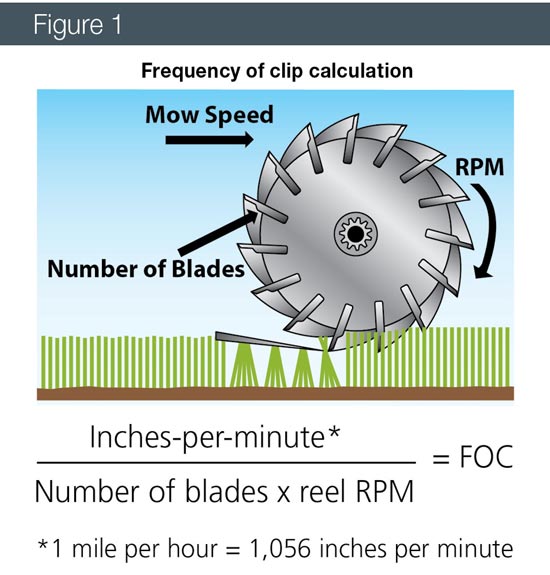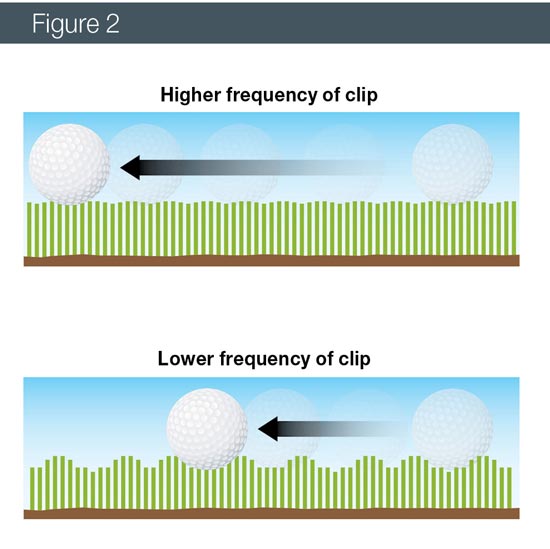
Clip art: Increasing frequency of clip furnishes a smoother, more consistent surface, leading to better ball roll. Images courtesy of Jacobsen
Even as the economy begins to recover, many golf course superintendents will continue to face budget restrictions and increasing pressure from management and golfers to deliver high-quality course conditions. Such challenges have led many turf managers to take a renewed interest in frequency of clip (FOC).
What is frequency of clip? If you were to ask 10 superintendents, you’d likely get 10 different answers. Frequency of clip is simply another measurement superintendents can add to their toolbox of mower settings to better manage turfgrass, much like height of cut and Stimpmeter readings.
FOC measures the distance between mower shear points (or clips) in the grass. It is affected by three separate inputs: number of reel blades, reel speed and mower speed (Figure 1, below).
Updated reel technology from the big three equipment manufacturers has breathed new life into the FOC discussion by allowing superintendents to control and adjust frequency of clip like never before.
“Frequency of clip is one of those things that, as superintendents, we probably don’t utilize to its full capacity,” says Scott Newman, GCSAA Class A superintendent at Spring Creek Ranch in Collierville, Tenn. “For us, FOC is part of the daily conversations we have about mowing heights and groomers. We adjust it before the member-guest to get green speeds up without rolling. But what I would say to other guys is, ‘Why not try it?’ It only takes five seconds to change.”

Figure 1. Frequency of clip is the distance between mower shear points in the grass. To calculate FOC, divide the inches per minute by the product of the number of blades and the reel rpm.

Figure 2. A higher frequency of clip means less distance between clips, more grass cut and increased ball roll (top). A lower FOC means more distance between clips, less grass cut and a slower ball roll. Note that a higher number setting on the mower indicates a lower FOC (bottom).
The actual FOC calculation can be derived using the formula in Figure 1. For example, an operator walk-mowing at 3.8 mph with a 15-blade reel turning at 2,200 rpm would be cutting with an FOC of 0.122.
It’s important to note that increasing (or tightening) FOC actually equates to a lower FOC value, and that decreasing FOC results in a higher value. Therefore, when a superintendent increases or tightens the clip rate, he or she is actually adjusting the FOC on the mower to a lower setting (Figure 2).
Frequency of clip, ball roll and height of cut
As the mower travels forward, the bedknife pushes against the grass in front of it. At the same time, the reel blade is gathering grass as it moves toward the bedknife. The opposing forces gather the grass together at the shear point. After the grass is cut, it springs back into place. This cutting action produces very small peaks and valleys in the grass, and although indistinguishable by the human eye, these high and low points have a profound effect on ball roll.
View an animation that illustrates frequency of clip:
On fairways and other higher-cut areas, some turf professionals suggest that the FOC be within 10 percent (higher or lower) of height of cut. At these higher heights of cut, where the FOC is greater than 10 percent of the height of cut, short, choppy wave patterns may appear, known as “marcelling.” Keeping FOC approximately equal to or less than the height of cut eliminates marcelling and improves ball roll.
On greens and similar low-cut areas, the relationship between FOC and height of cut is not as intrinsically related. Superintendents and technicians should experiment with different settings to determine what works best for their individual conditions.
Traditionally, a superintendent who wanted to increase ball speed would likely lower the height of cut and double-cut. Such practices not only cause extra stress on the grass, but they also require the use of more labor, water and chemicals. However, a superintendent preparing for a member-guest tournament can opt to tighten FOC to increase ball roll significantly without lowering the height of cut.
“For an upcoming tournament, I wanted to increase our green speeds by 3 to 4 inches, but I wasn’t keen on lowering the height of cut, and we didn’t have the time to double-cut,” says Mike Rienzi, superintendent at Kiva Dunes Golf Club in Gulf Shores, Ala., and a 19-year GCSAA member. “My technician suggested we tighten up the FOC on our walkers. I watched him do it, which took all of five seconds. We went and Stimped the greens after mowing, and we actually increased green speed by more than 4 inches. I was floored at how easy and effective FOC adjustment can be.”
For daily play, superintendents can adjust FOC to maintain current ball speed and actually raise the height of cut. Trevor Broersma, CGCS, of Washington National Golf Club outside Seattle, started experimenting with FOC adjustments earlier this year. “By playing around with the frequency of clip on our walking greens mowers, we were able to raise our height of cut from 0.115 to 0.130 and still maintain an 11-foot roll on our greens,” he says. “We also found that with the higher clip rate, we don’t have to mow every day. We are now rolling every other day, which is giving us the most consistent speeds we’ve ever had. It’s amazing.”
Making FOC mower adjustments
In the past, the only way to change frequency of clip was to change reel blade count and/or alter mowing speed. But equipment manufacturers have recently added blades to standard reels to help superintendents increase FOC quickly and easily. Jacobsen and Toro have added 15- and 14-blade reels to their lineups, respectively. In addition to changing blade count and mowing speed, all mowers offer some level of FOC control, most by using gears and pulleys.
Some manufacturers have taken FOC controls a step further. For example, Jacobsen mowers allow superintendents to adjust the FOC on an LCD screen in a matter of seconds. Furthermore, the mower’s electronically controlled reels are driven from individual motors separate from the tractor, which means the FOC remains constant even if the speed of the mower changes.
Although FOC is a precise formula, it is not always an exact science on the turf. Superintendents new to FOC should work with their technicians to experiment with different settings, usually moving up or down 10 to 20 percent at a time. To monitor changes, superintendents may use a prism to evaluate stragglers and record Stimpmeter readings after FOC changes. In some cases, superintendents have weighed clippings to compare grass volumes at different FOCs.
After experimenting with FOC and evaluating the results, superintendents will arrive at an ideal series of settings for day-to-day play, post-topdressing and post-aerifying, tournaments, and severe weather conditions. Some mowers allow up to six FOC presets to be programmed into the mower’s control box.
Once a superintendent understands how to implement frequency of clip, the measurement can be one more valuable management tool, and every golf course can benefit from an additional tool to enhance quality of play.
Adam Slick is the public relations and communications manager for Jacobsen.